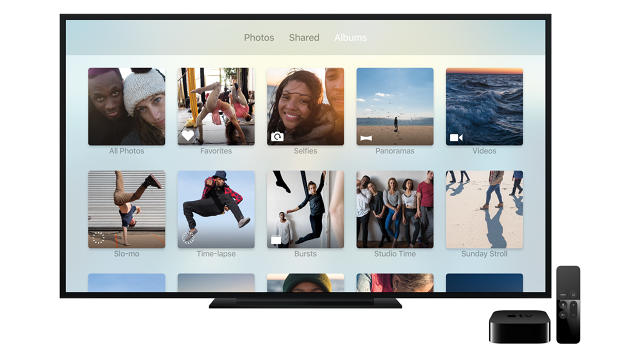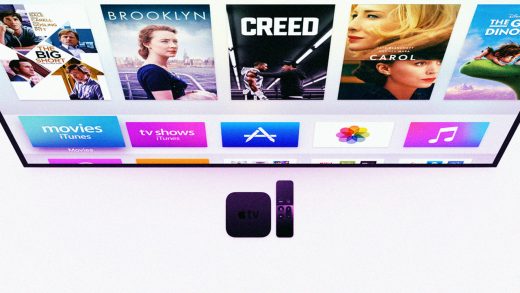Here Are Apple TV’s Biggest Challenges At WWDC And Beyond
If Apple gets its way, the Apple TV could become the centerpiece of the living room.
But it’s not there yet. While the fourth-generation Apple TV is far better than its predecessors, and matches up well against rival streamers like Roku and Amazon’s Fire TV, replacing people’s cable boxes as the go-to source of info and entertainment won’t be easy.
It probably won’t happen overnight either, as some of Apple TV’s biggest challenges are endemic of the entire media industry. Whether Apple has answers at next week’s WWDC event or not, here are the major problems that Apple TV—and all media streamers, for that matter—must address:
Break Down The Walls Between Apps
Streaming video may give you more options and flexibility than traditional TV, but it also creates some new headaches. Instead of having a unified channel guide and DVR-style watchlist, like a cable box, devices like Apple TV force you to dig through several different apps when you’re browsing for something to watch.
So far, other media streamers have only come up with half-baked solutions:
• Amazon Fire TV places recommended and recently watched videos directly on its home screen, but nearly all of those suggestions come from Amazon Prime and Amazon Video, to the exclusion of other services.
• Android TV has a Recommendations bar that pulls from various apps, but it rarely seems to understand your viewing habits and is missing some major streaming services like Netflix.
• Roku has a “Feed” feature for tracking new movies and TV episodes across different streaming services, but it’s not useful for browsing videos that are out already, and the number of services is limited.
What might an Apple solution look like? The Apple TV could have a separate menu, one swipe away from the home screen, that shows recent and recommended episodes from across different apps, similar to the proactive “Siri Suggestions” menu on the iPhone. Or perhaps apps themselves could become more dynamic on the home screen, with links to recent or suggested videos instead of static icons.
Neither solution would solve the underlying problem, which is that some media companies don’t want their streaming videos to appear in unified interfaces to begin with. According to Jackdaw Research analyst Jan Dawson, these companies fear that they’d lose control of their users and their brands by pushing content outside their apps. A company like Fox, for instance, would much rather have you remain in the Fox app instead of switching to Netflix or ABC when you’re done with a particular show.
“The app model really serves the content owners well. They get to own and brand that experience, and help promote their brand in that way,” Dawson says. “From a user perspective, it’s counterproductive because you’re going down all these rabbit holes.”

Dawson believes that media companies will come around in time, at least for Apple. He notes that Apple has managed to rally media companies to its side before with efforts like iTunes and iBooks, and successfully wooed big banking companies into joining Apple Pay.
But Mark Hall, head of product at music video streaming service Vevo, believes that ultimately media companies will still want you to end up within their respective apps.
“I think we’ll get to a place that’s a little bit more fluid than it is now,” Hall says. “It’ll be much more of a deep-linking experience, but once you’re into it you’re very clearly into the Netflix interface, or the Vevo interface, or the ESPN interface, where there are additional paths of navigation without always having to go through Apple or Amazon or Google or Roku.”
Eventually, Apple could bypass this whole problem by offering its own streaming video service, covering all the programming that people might want to watch. But given how many setbacks Apple has reportedly suffered in trying to negotiate such a service, unifying the apps that already exist might be the easier path in the short run.
Make Universal Search That’s Actually Universal
Apple has already unified some apps through Siri, which can search across several video sources including Netflix, iTunes, Hulu, and HBO.
But while Apple has expanded the number of services that support Siri since launch, search as a whole is still confined to on-demand movies and TV shows (and still leaves out some higher-profile services, such as Comedy Central and Crackle). Other concepts such as sporting events, live specials, YouTube videos, and music videos are beyond Siri’s reach.
“If you could voice search for that video—play ‘Lemonade’—that’s a clear path of entry that we want to support at Vevo, where someone can do voice search for a specific music video and begin a journey that starts with that video,” Hall says.
The big challenge for Apple will be to expand search into new areas without inviting spammy results. “The problem that you have is that apps can overdo it,” Dawson says. “They can pick hundreds of terms, and say ‘Oh that’s relevant to what we’re doing,’ and have some kind of content that links to that.”
On a smartphone, that’s not such a big deal, Dawson says, but sifting through dozens of results on a TV screen could easily become overwhelming. He expects that Apple will continue to expand Siri search on Apple TV slowly, rather than opening the floodgates to all app makers overnight.
Turn The TV Into A Hub For Your Home
The living room, of course, isn’t just a place to watch TV. With devices like Amazon Echo and the upcoming Google Home, tech companies are now treating this space as a flashpoint for the larger battle to control your entire household.

Ahead of WWDC, rumor has it that future Apple TV devices will compete directly with Amazon’s and Google’s virtual assistants for answering queries, playing music, and controlling smart-home devices. As VentureBeat claims, this could include more powerful speech recognition in the Siri Remote, or speakers and microphones built into the Apple TV box itself.
Although Dawson is skeptical about mainstream adoption of smart-home products, he acknowledges that Apple must have a more persistent presence in the living room, especially as it tries to reposition itself as a services company.
“Apple wants you to live in Apple’s ecosystem, and if there are gaps in your life where Apple’s ecosystem isn’t present, that’s an opportunity for somebody else, whether that’s Amazon or Google or Samsung or whoever else it might be,” Dawson says.
A smart speaker might make sense for Amazon, Dawson says, because its smartphone efforts failed spectacularly and tablet sales have stagnated, leaving the company without much of a device presence. Apple has the luxury of leaning on iPhones, iPads, Apple Watches, and Macs to provide Siri throughout the house, while turning the Apple TV into a big-screen hub.
But to reach that point, Apple must first conquer television itself. If the company can replace your cable box as the heart of your living room, it may have the best chance at winning the smart-home ecosystem land grab.
Read More:
Fast Company , Read Full Story
(24)



